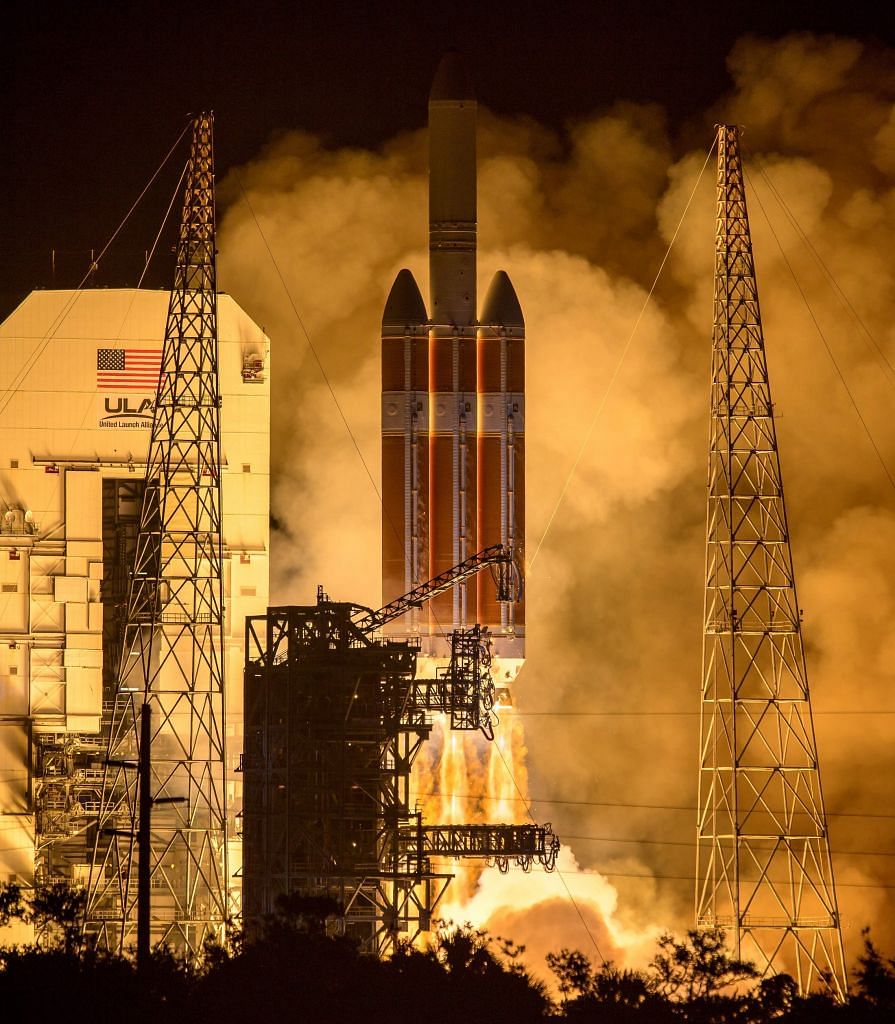TAMPA • Nasa yesterday blasted off a US$1.5 billion (S$2.1 billion) spacecraft towards the Sun, on a historic mission to protect the Earth by unveiling the mysteries of dangerous solar storms.
"Three, two, one, and lift-off!" said a Nasa commentator as the Parker Solar Probe lit up the dark night sky aboard a Delta IV-Heavy rocket at 3.31am (3.31pm Singapore time) from Cape Canaveral, Florida.
It came after a failed attempt the previous day, when a last-minute alarm caused the United States space agency to miss its 65-minute weather window.
The launch was initially supposed to take place on July 31, but several technical issues pushed the attempt back to Aug 11 .
Looking on at the launch was astrophysicist Eugene Parker, who first theorised the existence of the solar wind in 1958.
Now 91, Professor Parker of the University of Chicago, the first living scientist to have a space probe named in his honour, flew to Cape Canaveral to witness his first rocket launch.
"I really have to turn from biting my nails and getting it launched to thinking about all the interesting things, which I don't know yet, (that) will be made clear, I assume, over the next five or six or seven years," he said in a Nasa interview which was posted on the agency's Twitter account.

"It's a whole new phase, and it's going to be fascinating throughout... All I can say is wow, here we go. We're in for some learning over the next several years."
The unmanned spacecraft will zip past Venus in six weeks and make a first rendezvous with the Sun, the star closest to the Earth, a further six weeks after that.
It aims to get closer than any human-made object in history to the centre of our solar system.
The probe is designed to plunge into the Sun's atmosphere, known as the corona, during a seven-year mission.
It is protected by an ultra-powerful heat shield that can endure unprecedented levels of heat, and radiation 500 times that experienced on Earth.
Nasa has billed the mission as the first spacecraft to "touch the Sun", In reality, it should come within 6.16 million km of the Sun's surface, close enough to study the curious phenomenon of the solar wind and the corona, which is 300 times hotter than the surface of the Sun.
The car-size probe is designed to give scientists a better understanding of the solar wind and geomagnetic storms that risk wreaking chaos on Earth by knocking out the power grid.
These solar outbursts are poorly understood, but pack the potential to wipe out power to millions of people.
A worst-case scenario could cost up to US$2 trillion in the first year alone and take a decade to fully recover from, experts have warned.
"The Parker Solar Probe will help us do a much better job of predicting when a disturbance in the solar wind could hit Earth," said Dr Justin Kasper, a project scientist and professor at the University of Michigan.
Knowing more about the solar wind and space storms will also help protect future deep space explorers as they journey towards the Moon or Mars.
"Until you actually go there and touch the Sun, you really can't answer these questions," project scientist Nicola Fox told CBS News.
"Why is the corona hotter than the surface of the sun? That defies the laws of nature. It's like water flowing uphill, it shouldn't happen.
Scientists have wanted to build a spacecraft like this for more than 60 years, but it was only in recent years that the heat shield technology advanced enough to be capable of protecting sensitive instruments.
AGENCE FRANCE-PRESSE

